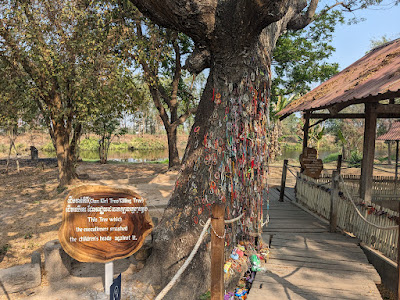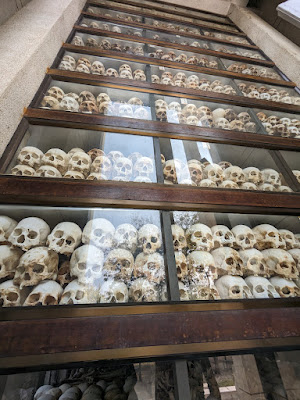Phnom Penh......A Place to never forget....
 |
| S21 and the Killing Fields |
We waited until we arrived in Phnom Penh to start diving deeper into Cambodia's dark past. We both knew it was going to be very emotional and would take a toll but was important to learn about. If you are unaware of the Khmer Rouge and Pol Pot, please read more on the subject, it deserves our remembrance.
As a brief non-political introduction - The Khmer Rouge gained power in Cambodia slowly during the Vietnam War, or the American War as it's called over here. However its roots started growing in the 1940’s opposing French colonizers. The bombing of Cambodia during the Vietnam War pushed people towards the major cities for safety and the resentment pushed people into the ranks, mostly rural uneducated young boys.
On April 17, 1975, the Khmer Rouge took control of the city of Phnom Penh and evacuated millions. They told the population that they were going to be bombed and needed to leave. The regime drove everyone out, no one was spared, not the sick, not the old or pregnant, everyone was led away, by force if needed. Thousands died along the way. As one survivor put it, “We thought they were here to liberate us, help us.” The smiling faces in photographs quickly changed as more and more soldiers arrived.
Pol Pot dreamed of an agrarian Maoist-Marxist-Leninist society and used fear, torture and murder to justify his dystopian delusions. His enforcer was Kang Kek Iew, better known as Comrade Duch, who was tortured himself before taking a seat next to Pol Pot. He used methods which produced the most efficient, cost saving measures while at the same time maximizing pain and compliance. His torture techniques were then taught to young boys who practiced on animals before graduating to humans.
Duch would not allow the boys to take out their anger during torture and if caught, they would be next. After hearing of one of the female prisoners being raped he replaced the interrogator/torturer with a woman. He insisted on documenting everything and used a mug shot chair from the French police to photograph each person, all meticulously.
The third and highest floor was reserved for the majority of prisoners where they were shackled by the ankles and laid in straight rows. The barbed wire surrounding the hallway was erected after a suicide attempt.
The second and first floor housed those who were soon to be interrogated and tortured. They were held in small cells and shackled to the ground with an ammo canister for a toilet. Adults weren't the only prisoners being held captive and I couldn't help but think that students here just days before the arrival of the Khmer Rouge were living a very different reality then they were now.
When the Vietnamese liberated the city four years later they found just seven remaining adult prisoners and five children. They also found the journals and photographs the regime kept on every person, at least those not burned or otherwise destroyed. These are all on display, as are the rudimentary torture tools and skulls of victims.
The entrance fee of $10 includes an audio guide which provides information and stories from survivors recounting their horrific experience. It was a very moving but needed experience to truly understand the atrocities committed here.
We walked around the block for lunch both somber and quiet. We thought about waiting until the next day to experience the Choeung Ek Genocidal Center, just one of over 300 killing fields, but decided it was best to do them on the same day.
We took a tuk tuk about 40 minutes outside of Phnom Penh. Entrance was $6 and also included an audio guide. The narrator guided us around the fields through numbers. This site was previously a Chinese graveyard and some tombstones were still visible.
The tour started where trucks would bring prisoners from S21 to be killed as they ran out of room inside the city limits. No bullets were used in these executions as that's not cost effective. Most people were killed by farm tools, one exception being the killing tree. The plaques are disturbing to read but this one in particular was very difficult.
They were then thrown into large pits and doused with DDT which both concealed the stench and ensured their death.
There were a few buildings where the prisoners waited in complete darkness for their execution. They listened to blaring propaganda music all day and at night noise from the diesel generators used for light for the executioners. This sound is also heard with the audio guide.
The killing quota was enforced with the threat of the executioner being killed next if he failed.
There is a small pond in the back of the field. You are encouraged to sit and listen to captured citizens recount stories of life under the regime's power. This was perhaps the most powerful part of the tour.
A giant pagoda was erected in 2012 and houses skulls of those that perished. They are classified by male, female and age with colored stickers, indicating the tools used to deliver a fatal blow. Every few months, caretakers comb the fields for bone fragments as the rain is still pushing them up. They are collected and preserved.
It is estimated that 25% of Cambodia’s population died under the regime's reign.
Both places were unforgettable and each were professionally presented with the dignity this experience deserves. On the ride back, I couldn't help but look at Cambodia and its people in a new light. The fierce resilience is displayed on their smiling faces, even while underneath the past is remembered and sworn never to be repeated.
Two names of survivors stand out but are not meant to diminish the countless victims; Chum Mey and Vann Nath. After visiting both locations we watched S21: The Khmer Rouge Death Machine filmed in 2003 and available for free on YouTube. Both men were interviewed in the powerful documentary that I would suggest watching after your visit.
S21



































Incredible. Thanks for bringing this out. It’s important that things like this are not forgotten nor minimized…
ReplyDeletePowerful. I lived during that period and never knew about it. That's how I felt after visiting Dachau Concentration camp in Germany. Stays with you awhile. 😢
ReplyDelete